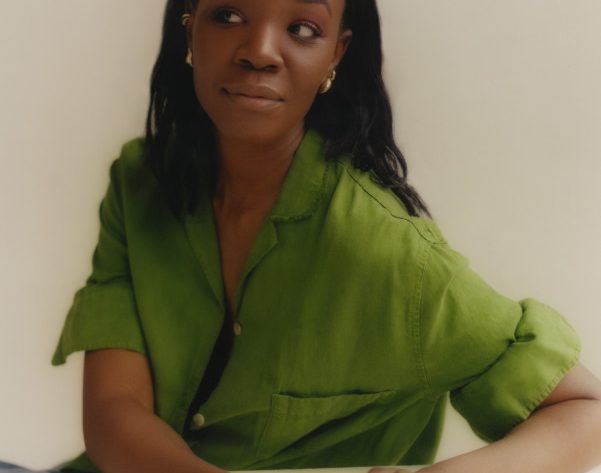Photo: Courtesy of Recho Omondi
In our long-running series “How I’m Making It,” we talk to people making a living in the fashion and beauty industries about how they broke in and found success.
Recho Omondi has only been starstruck once in her life, and it was, according to this author, under entirely understandable conditions: “It was at a house party,” she says, and Beyoncé walked through the door.”
This proves to be much more than merely a fabulous story to share during an interview with Fashionista. In fact, it says something about how Omondi has made a name for herself in the American fashion landscape.
Growing up throughout the Midwest while also clocking significant time throughout Europe, the Kenyan American remembers being raised almost between worlds, from the small town in Oklahoma where she was born to spots like Belgium and Bangkok and, eventually, New York City, where she’s lived since she graduated from Savannah College of Art and Design (SCAD) Atlanta. Fashion, though, was always a part of her story, with her passion for the craft perhaps stemming from her love of glossy magazines or the fine needlework being used to sew her ballet costumes.
In 2013, after working in luxury retail at Barneys and in pattern-making for brands like Calvin Klein and Theory, she founded her eponymous label, OMONDI, influenced by the duality of her Kenyan heritage and New York lifestyle. It was, by all external markers, a success. But she still had more to say — so in 2018, she launched “The Cutting Room Floor,” a podcast that platformed those candid, off-hours conversations Omondi was having with colleagues and friends.
The show wasn’t extensively planned, nor did she even intend on doing it full-time. But then, the pandemic hit in 2020, and Omondi made the decision to dissolve her clothing brand. The podcast transformed from a creative and emotional outlet into a viable — and more importantly, fulfilling — business.
Now five years in, Omondi has interviewed a fantastically wide range of industry-favorite figures, like beloved womenswear designer (and fellow SCAD alumnus) Christopher John Rogers, LVMH Graduate Prize winner Peter Do and former Glamour Editor-in-Chief Cindi Leive.
Which is where the Beyoncé tale comes in: Heralded for her direct and inquisitive interview style, Omondi isn’t one to cower to a subject — just like she isn’t one to get intimidated by any old celebrity. Any “The Cutting Room Floor” listener knows: She’s simply looking for the answers to the questions about the business that folks have been asking for decades. Soon, she’ll be doing so on new channels — you can catch “The Cutting Room Floor” on YouTube come January 2024 (with full episodes still appearing on Patreon).
Read on to learn how she’s gotten here, and other highlights from our conversation.
Tell me about the origins of your interest in fashion, before you pursued it as a career.
I just always loved it. I don’t know that that’s an exciting answer, but I came out of the womb that way. Since I was little, I’ve always had a very strong reaction to and opinion about what I wore. I’ve always had a very attentive eye, noticing what people were wearing — their jewelry and all the small little details.
I also did dance a lot growing up — competitive dance, ballet — and that’s a lot of costuming and sewing your recital outfits. That had something to do with it, too.
You were born in Oklahoma and raised throughout the Midwest while also spending time in Europe. Did your time in small towns, paired with your Kenyan heritage, influence the way you think about creativity and self-expression?
It must have — all of our upbringings influence us. It was this strange dichotomy. I grew up in really small towns, but I was also traveling the world. I don’t know that most people do both of those things.
To this day, I’m very grateful that I grew up in the Midwest. I love the Midwest. I love the values that come with it. I know some of the most amazing, humble, hardworking people you’ll ever meet (who are from the Midwest). It was very much culture shock moving to New York and meeting people who are not like that. To this day, I always say I can spot a Midwesterner anywhere in New York City.
But when you have immigrant parents and you’re traveling a lot — yeah, it’s weird. You see the world in this very global sense. I grew up with people who have never even left their hometown, who have a very different worldview.
I think the two (perspectives) gave me this zooming in, zooming out capability, understanding how different people are seeing the world and that there’s no one reality. All of us are living through our own experiences.
Walk me through your career path from the time you graduated from SCAD, where you studied fashion design and pattern-making, to your time at working in luxury retail and in pattern-making — and eventually founding OMONDI. What lessons did you learn in those early days that you still carry with you today?
I was just really impatient. I had something I wanted to say and I wanted to get it out. I say that running that company was definitely another four-year degree, because I learned so much about business and what to do and what not to do. Raising money, compliance, taxes, making a lot of mistakes, wasting a lot of money — basically everything they tell you as to why you should wait to start a brand. But I don’t take it back at all. I learned so much.
Just for context, growing up from K through 12, I always got good grades. I was always a pretty good student. Then, when I got to college, it was the first time I realized I could manage my own time, which was very shocking to me, but I fell in love with it — that I could take a class at 2:00 p.m. and I could schedule my time the way I wanted. Once I realized that was a possibility, going back to a desk after graduation, not to be dramatic, took a toll on me. I did not like the idea of sitting somewhere from nine to five, especially when I had already proven that I could be successful with my own free time.
To this day, I’m not somebody who can do that. I’m not someone who’s meant to be a cog in the wheel of a big machine. I don’t think I had any understanding that could be a symptom of entrepreneurship. I started nanny-ing — nanny-ing in New York pays really well — so that I could start to wiggle around my own time. That was how I ended up launching OMONDI.
Five years after launching OMONDI, you started “The Cutting Room Floor” as an outlet to, as you told 1 Granary, “talk about how difficult it is to run a fashion business.” How did that experience come about?
I was running a brand, and I was frustrated and overwhelmed. I just needed an outlet. At that point, I had already cultivated a lot of relationships within the fashion business that were either my colleagues or my friends or whatever.
Fashion is one of those things that feels so opaque and no one has access to it. Even when we’re in it, there’s still this feeling of, ‘I’m not good enough for it.’ Or, there’s some other job that’s on a bigger pedestal than the job that you’re at. You could always feel like you’re climbing something and think, ‘That’s so interesting that I’m relatively on the inside, but again, I always feel like I’m on the outside.’ But to be on the outside, I saw these people that not everybody knew, and (I wanted to) talk to them.
I didn’t think twice. I was just like,'”I’m going to buy equipment, and I’m going to start talking.’ If you go back and listen to the first episode, the sound quality is terrible. I was recording in my living room. But it was definitely mission-based, I will say that, from the beginning.
You’ve also said that your background in design lends you a very unique perspective on how to interview people and what to ask, regardless of their specialty. Do you have a standard, tried-and-true approach for each interview, or does it vary depending on the guest?
It doesn’t really differ from guest to guest, although I do check the temperature. Everyone’s temperature is a little bit different. I think there’s a lot of EQ that goes into being a good interviewer. It’s something I’ve been working on since I started doing it, and especially since I started to see there was a bit of momentum — immediately I was like, ‘Ooh, let me see if I can do this the best I possibly can.’
But I do think my personality is a big part of the way I interview, which is that I’m a deeply curious person. It’s not even meant to be provocative. It’s not nice to back somebody into a corner. I’m just genuinely curious. That’s the basis of how I interview. Although, I think what people are referring to when they refer to my interview style is how I’m willing to challenge people.
That comes from the fact that I’ve read fashion media for years. For years. And I always felt like most things I consumed were very surface-level, and it frustrated me, because I feel like intellectual audiences are actually deeply underserved. Audiences have gotten so much smarter, and I think you have to dignify your audience and treat them like adults.
That was my own personal quest: my thirst and insatiable desire for more information, more storytelling. But as far as guest-to-guest, I’m pretty much the same. I also think — I talked about doing ballet — that I’m a natural-born performer, in the sense that I’ve never had stage fright. There’s not anyone I’m intimidated by, as far as doing my job, which is to ask them questions. That’s not my personality. I think that’s why I can treat everybody the same, which is a double-edged sword, by the way: People are so scared of me because they’re like, ‘What is she going to say?’ But I also think people tune in because they’re like, ‘What is she going to say?’
If you were to go through the highlight reel of “The Cutting Room Floor” thus far, what would be the big moments that stand out to you? Any particular guests or episodes?
I have so many. This is the thing about my work, though, is that they’re not going to be buzzy, clicky names. I like to excavate, in a way, and go find people who are really knowledgeable.
She might not be the biggest name, but I loved Teri Agins, who was a journalist at the Wall Street Journal for 20 years, covering the fashion beat by herself. That was one of my favorite episodes. I loved Mina White, who’s a model agent at IMG and spearheaded the curvy-girl movement. I loved Mickey Drexler, just because, how can you not? For someone who’s a CEO, he actually has a very candid personality and doesn’t do a lot of corporate talk. He’s a straight shooter, and that was amazing. I have so many. It’s hard because when you’re editing as meticulously as I am for each episode, every single one is your baby. You spend so much time with each one.
“The Cutting Room Floor” will be making a move to YouTube come 2024! What can you share about that project?
Well, okay, first of all, I’ve been podcasting, for what? Five years now. After a while, I realized it was something that we could really lean into. For a long time, the audience has been saying they wanted video. I did start taping it, but (these were) just small clips on social media. That was the extent to which we showed video.
The move to YouTube is a natural thing to do. But to me, YouTube was such a daunting platform. I have such respect and reverence for YouTubers or anyone publishing content on that platform. I wanted to justify my presence, I guess. It had to be the right time. I hired a production company. I wanted for it not to be overly polished or overly produced, and I guess that’s what we’ll see when it comes out. It’s also a platform with earning potential.
Speaking of which, “The Cutting Room Floor” launched on Patreon in June 2021, where you’ve since built a thriving community. How has that platform impacted the podcast as a business?
I’ve found Patreon to be so incredibly rewarding. I kind of lay low, do my own thing, and invite whoever wants to be on the journey to come with, but I don’t think I realized the magnitude of community that could be built there or the fact that you could get a full salary from producing content there.
People have a huge misunderstanding about Patreon. I think people see it as GoFundMe, or as if it’s a kind of crowdsourcing. I say this because so much of my mission is about championing creatives, no matter what their discipline is, but if you’re someone who has a craft or a skill or something you feel is worthy of value, go behind a paywall and promote it. It’s worked for me — I can’t say that about everything or everyone, but I don’t think people should sleep on platforms like this. And if you’re someone who knows a creator who’s behind a paywall, support them if you can. I know a handful of people who make handsome livings from the content they’re selling online.
You’ve spoken about the fact that when you first entered fashion, there was nothing to guide you — that even with investors, there were so many other roadblocks. What advice would you give to someone just starting out?
The first thing is: Do you want a job or do you want a career? Then I would say: Do you want to run a business, or do you want to work for somebody else? For me — and it took me a long time to realize this — I’m a creator first. I just like making things. That’s also why I think I struggled with the influencer economy, and feel much better about the creator economy, which I find to be two distinctly different things.
Something that took me a long time to realize is that I actually am an entrepreneur. As a creator, you can be that. I want to run my own business. I want to make my own money. I want to be able to do that through creating.
Now, there’s all different types of creativity, so I’m not the one to give guardrails of what that looks like. There’s some people who are really creative and honestly are better creatives within the confines of a structured company. To each their own. But I would definitely do the work of exploring what that is, because for me, collaborating with somebody, partnering with people, is very exciting. Working for someone is not something I can ever see myself doing.
But if something didn’t work out and I found myself in a sink-or-swim situation, I would of course go get a job, and I have enough hard skills that I believe I’m employable. But it’s not my first choice. I’m going to do whatever it takes until the wheels fall off.
I’ve worked in all different corners of the business. I’ve worked in retail. I’ve worked in luxury retail. I’ve worked in wholesale. I’m a designer, so I’ve worked in product development and in factories. I’ve done internships at modeling agencies. Funnily enough, the one corner of the business I had never worked in was media.
If you do want to work in fashion, I would spend your 20s exploring all the different areas, if you can. Every single job, no matter if you hate it, has something to offer you. You have something to learn there. That’s your right as an employee.
It doesn’t have to happen right away. One mistake I made was thinking I should have arrived by 26. I’m realizing you have to give yourself patience to grow into your dreams.
This interview has been edited and condensed for clarity.
Want the latest fashion industry news first? Sign up for our daily newsletter.



